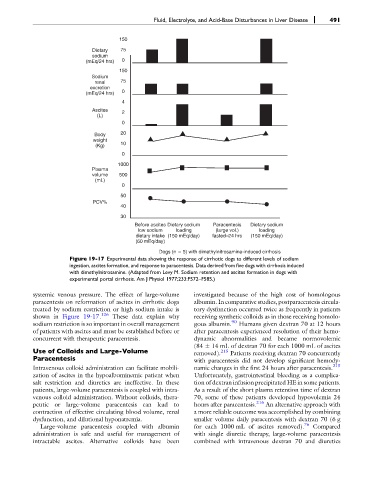Page 503 - Fluid, Electrolyte, and Acid-Base Disorders in Small Animal Practice
P. 503
Fluid, Electrolyte, and Acid-Base Disturbances in Liver Disease 491
150
Dietary 75
sodium
(mEq/24 hrs) 0
150
Sodium
renal 75
excretion
(mEq/24 hrs) 0
4
Ascites 2
(L)
0
Body 20
weight
(Kg) 10
0
1000
Plasma
volume 500
(mL)
0
50
PCV%
40
30
Before ascites Dietary sodium Paracentesis Dietary sodium
low sodium loading (large vol.) loading
dietary intake (150 mEq/day) fasted–24 hrs (150 mEq/day)
(60 mEq/day)
Dogs (n
5) with dimethylnitrosamine-induced cirrhosis
Figure 19-17 Experimental data showing the response of cirrhotic dogs to different levels of sodium
ingestion, ascites formation, and response to paracentesis. Data derived from five dogs with cirrhosis induced
with dimethylnitrosamine. (Adapted from Levy M. Sodium retention and ascites formation in dogs with
experimental portal cirrhosis. Am J Physiol 1977;233:F572–F585.)
systemic venous pressure. The effect of large-volume investigated because of the high cost of homologous
paracentesis on reformation of ascites in cirrhotic dogs albumin. In comparative studies, postparacentesis circula-
treated by sodium restriction or high sodium intake is tory dysfunction occurred twice as frequently in patients
shown in Figure 19-17. 126 These data explain why receiving synthetic colloids as in those receiving homolo-
sodium restriction is so important in overall management gous albumin. 90 Humans given dextran 70 at 12 hours
of patients with ascites and must be established before or after paracentesis experienced resolution of their hemo-
concurrent with therapeutic paracentesis. dynamic abnormalities and became normovolemic
(84 14 mL of dextran 70 for each 1000 mL of ascites
Use of Colloids and Large-Volume removed). 215 Patients receiving dextran 70 concurrently
Paracentesis with paracentesis did not develop significant hemody-
Intravenous colloid administration can facilitate mobili- namic changes in the first 24 hours after paracentesis. 215
zation of ascites in the hypoalbuminemic patient when Unfortunately, gastrointestinal bleeding as a complica-
salt restriction and diuretics are ineffective. In these tion of dextran infusion precipitated HE in some patients.
patients, large-volume paracentesis is coupled with intra- As a result of the short plasma retention time of dextran
venous colloid administration. Without colloids, thera- 70, some of these patients developed hypovolemia 24
peutic or large-volume paracentesis can lead to hours after paracentesis. 216 An alternative approach with
contraction of effective circulating blood volume, renal a more reliable outcome was accomplished by combining
dysfunction, and dilutional hyponatremia. smaller volume daily paracentesis with dextran 70 (6 g
Large-volume paracentesis coupled with albumin for each 1000 mL of ascites removed). 76 Compared
administration is safe and useful for management of with single diuretic therapy, large-volume paracentesis
intractable ascites. Alternative colloids have been combined with intravenous dextran 70 and diuretics

